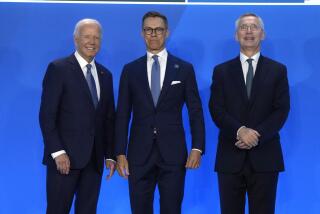NATO, Ex-Foes Sign Long-Delayed Arms Treaty
OSLO — The North Atlantic Treaty Organization and its former foes in Eastern Europe signed a historic but long-delayed treaty here Friday that aims to vastly reduce arsenals of tanks, artillery, armored vehicles and other conventional weapons in Europe.
The Conventional Forces in Europe (CFE) treaty was signed by the foreign ministers of the North Atlantic Cooperation Council, a new organization made up of the 16 members of NATO, Russia and seven other republics of the former Soviet Union and five of the old members of the now-defunct Warsaw Pact.
“We are partners now,” Norwegian Foreign Minister Thorvald Stoltenberg said at the signing ceremony after a two-day meeting here. NATO Secretary General Manfred Woerner added, “This is one of the most important cornerstones of a future European security architecture.”
The landmark CFE pact was first signed in Paris in November, 1990, after lengthy bargaining by NATO and the Warsaw Pact, then composed of six East Bloc nations, including the Soviet Union. But ratification was stalled by the Soviet Union’s breakup and disagreement among the republics over sharing of military equipment.
That dispute was settled among the republics last month, paving the way for Friday’s signing by Russia, Ukraine, Belarus, Kazakhstan, Moldova, Georgia, Armenia and Azerbaijan.
Now, the treaty must be ratified by the legislatures of each of the 29 new signatory nations, and Woerner said he hoped that would occur before a scheduled July summit meeting in Finland of the 52-member Conference on Security and Cooperation in Europe.
The signing followed talks among the NATO countries and the East European and ex-Soviet states that included what Woerner called “lively” exchanges between warring Armenia and Azerbaijan.
Tuohy, based in London, has been on assignment in Oslo.
More to Read
Sign up for Essential California
The most important California stories and recommendations in your inbox every morning.
You may occasionally receive promotional content from the Los Angeles Times.










